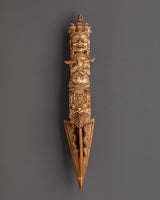

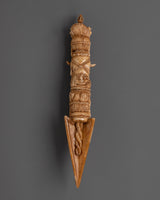
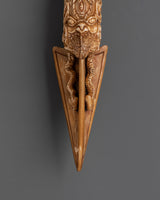

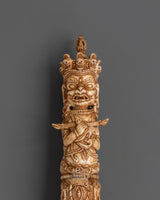
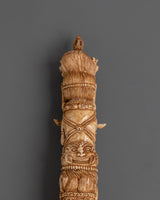
Handcarved Phurba Dagger | Buffalo Bone Ritual Tool for Spiritual Protection

100% AUTHENTIC

HANDMADE

FREE SHIPPING
Traditional Handcarved Phurba Dagger | Tibetan Energy Clearing
--------------------------------------------
Size: 31cm (Height) x 5.5cm (Width)
Weight: 0.26kg
Materials: Ethically Sourced Buffalo Bone
--------------------------------------------
About The Ritual Item :
This hand-carved phurba dagger is a captivating spiritual object used in Tibetan Buddhism to dispel negative energies and focus intention. Made from ethically sourced buffalo bone, it stands 31 cm high and measures 5.5 cm in width, weighing 0.26 kg, making it both lightweight and meaningful. Adorned with intricate carvings of wrathful deities and traditional symbols, this ritual blade showcases exceptional craftsmanship and profound spiritual significance.
The phurba, or kila, is a three-sided dagger representing the cutting through ignorance, desire, and aversion, known as the three poisons in Vajrayana Buddhism. Used in Tantric rituals, it is a sacred instrument associated with deities such as Vajrakilaya, invoked to transform negative energies and provide protection. Bone phurbas highlight impermanence and spiritual growth, making them especially important in advanced ceremonies. Whether for ritual practice, energy cleansing, focused meditation, or sacred display, this hand-carved phurba embodies centuries of spiritual meaning. It is an ideal choice for serious practitioners, collectors of Tibetan art, or anyone seeking a powerful protective spiritual tool.
Introduction To The Phurba :
The ceremonial dagger (Sanskrit: Kila; Tibetan: phurba) is essential for expelling evil and is considered particularly effective in neutralizing the forces obstructing Tantric Buddhist practice. It has ancient origins, first appearing in the Indian Rig Veda as the core blade of the vajra used by Indra to destroy the primordial cosmic snake Vritra. Kila, derived from Sanskrit, was most likely associated with Vedic sacrifices. Meditation on the Vajrakila Tantra, an early Indian scripture first promoted in Tibet in the eighth century by Padmasambhava, one of the founding teachers of Tibetan Buddhism, is used to invoke the three-headed Vajrakila Buddha.
How to Set Up Your Buddhist Shrine?
Find a clean, quiet, and uncluttered spot.
Please set up an altar table and cover it with an altar cloth that calls to you.
Place your sacred item (statue, thangka, or a picture of Buddha) at the center.

















